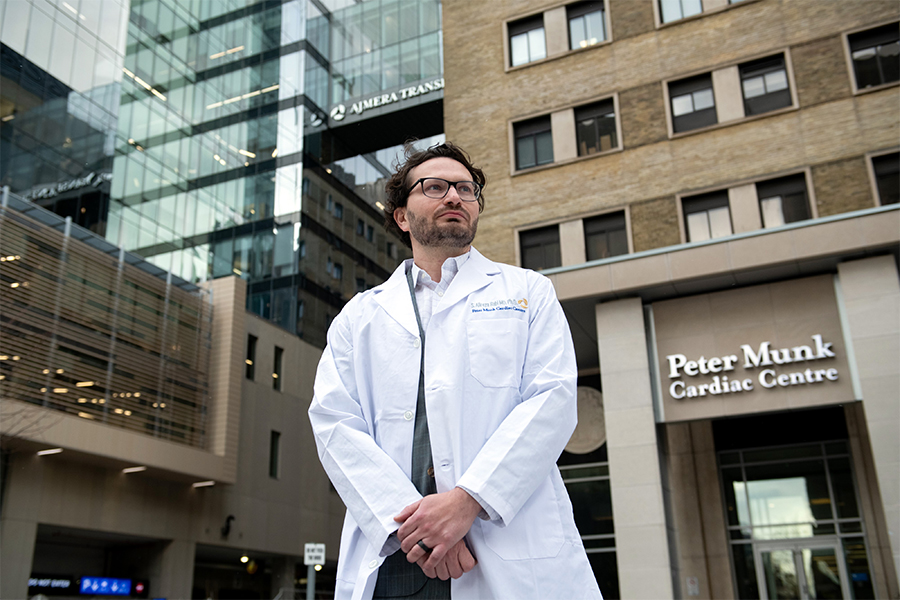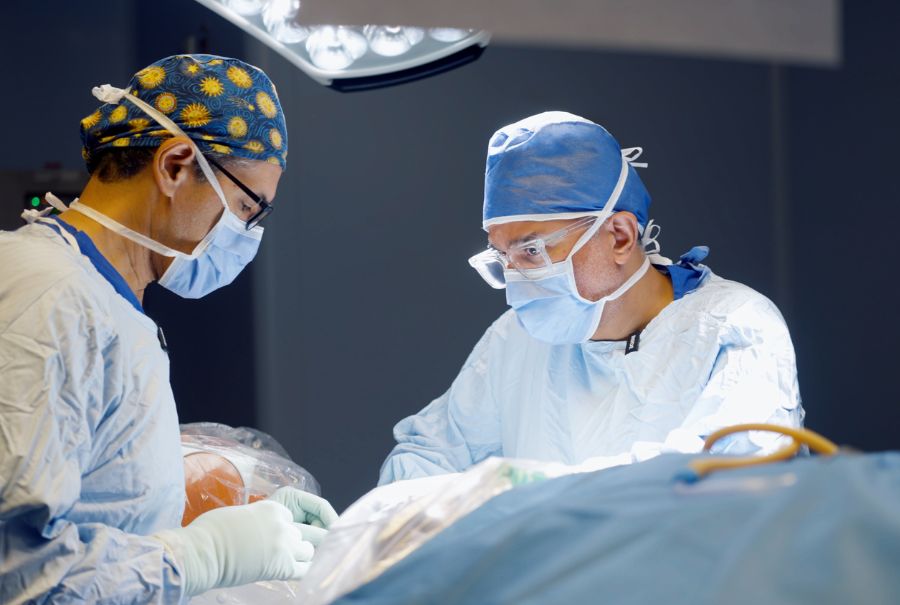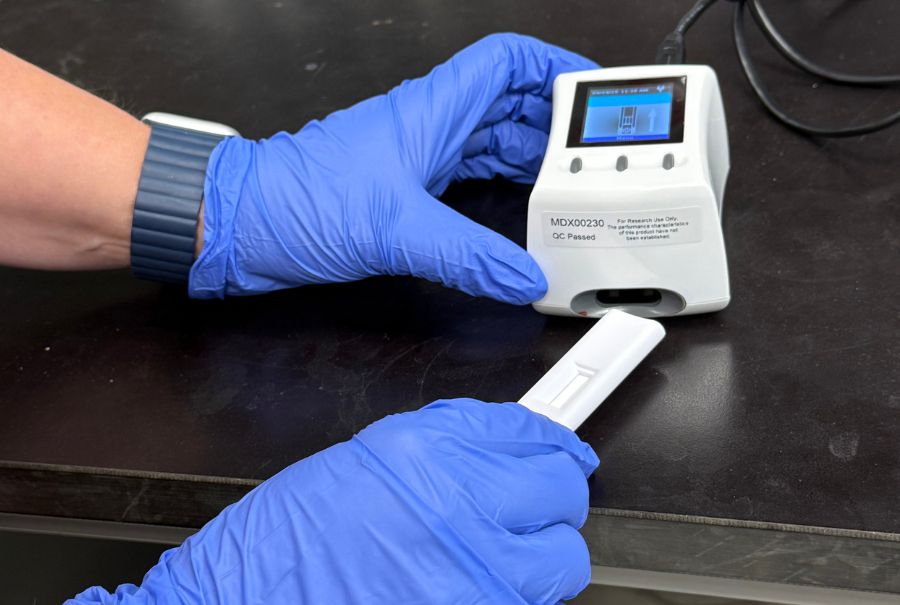“Robotic surgery is a critical part of the future of surgery. It will further enhance the capabilities of master surgeons,” says Dr. Shaf Keshavjee, Surgeon-in-Chief, Sprott Surgery. Photo by Tim Fraser.
A number of sophisticated machines are increasingly being used in complex surgeries that require a high level of precision and control that can’t be done by hand. Surgeons are using robots to perform minimally invasive surgeries – procedures that involve smaller incisions, less pain and better surgical outcomes – which makes a dramatic difference in patient recoveries. Surgeons in the Sprott Department of Surgery are employing a number of innovative technologies in many procedures, from nipple-sparing mastectomies to minimally invasive gastrointestinal (GI), lung, prostate, gynecological and kidney cancer surgeries. The result is a world-class surgical centre that’s pioneering new robotic techniques that are revolutionizing patient care.
Breast cancer surgery
Dr. Tulin Cil is in the midst of a North American–first clinical trial looking at how robotic procedures can help women undergoing nipple-sparing mastectomies. Traditional mastectomies – the surgical removal of the breast to remove cancer or to reduce the risk of developing it – often involve taking off the nipple and areola, but now there is a possibility to perform total skin- and nipple-sparing mastectomies. “Nipple sparing is done more and more, with immediate breast reconstruction at the same time,” says Dr. Cil. In a traditional nipple-sparing mastectomy, the incision is placed on the breast and there is limited visibility. Using robotics, an incision is made in the underarm area, and the breast tissue is then removed through that incision. Because the incision is small, there’s minimal scarring afterwards. Robotic instruments, explains Dr. Cil, help doctors more easily manoeuvre around tight areas, and they provide greater visibility inside the breast, which makes it easier for surgeons to see tissue more clearly. “It allows us to visualize those borders really well,” says Dr. Cil, who adds that this kind of minimally invasive procedure lowers infection risks and reduces the chance of nipple and skin death. Next up Dr. Cil is planning on recruiting more patients for this groundbreaking study, which was delayed due to COVID-19. She’s also looking to collaborate more with plastic surgery colleagues to continue improving the cosmetic and quality of life outcomes for breast cancer surgeries.
Dr. Tulin Cil, Surgical oncologist and Head, Breast Surgical Oncology, Division of General Surgery, Sprott Department of Surgery
GI/abdominal surgery
Surgeons need training – especially when it comes to the cutting-edge robotic procedures being used in Sprott Surgery. To help get people up to speed on the latest robotic technologies, Dr. Allan Okrainec is heading a new surgical education and simulation centre at the Michener Institute of Education at UHN. Dr. Okrainec, who specializes in minimally invasive GI and abdominal surgery, says the new simulation hub will help advance minimally invasive surgical techniques among surgeons, nursing staff and anesthetists. With a focus on robotic and image-guided surgeries, and using artificial intelligence and virtual reality training, physicians will be able to learn how to use the robots specific to their surgical subspecialty, he explains. “We can train people around the world in these surgeries,” says Dr. Okrainec. Phase one, which was just completed, focused on building a simulated operating room where surgical procedures can be rehearsed as a team. This operating room will allow surgeons to train on the latest surgical robots and practise image-guided surgeries. Next up Phase two of the simulation centre will involve the construction of a facility that will house 10 mini operating room bays, which will allow more surgeons to come to the centre to learn new procedures and perform surgical simulations on-site.
Dr. Allan Okrainec, Head, Division of General Surgery, Sprott Department of Surgery; Peter A. Crossgrove Chair in General Surgery and Director, Temerty Advanced Surgical Education and Simulation Centre
Urology
Dr. Jason Lee is passionate about using robotics to “reduce the footprint of surgery,” especially in his specialty, kidney disease. With more robotic surgery platforms entering the market, and with increasing advances in minimally invasive operations, more innovative surgical techniques are available to doctors than ever before. “I’d like to ensure our patients have access to all this cutting-edge technology,” he says. Dr. Lee is particularly interested in how robotics can help transform the treatment of urologic conditions, such as kidney and prostate cancers. Robotics have allowed surgeons to approach these cancers in novel ways, such as accessing tumours in hard-to-reach locations. For example, doctors can now use a robot to reach the kidneys through a patient’s back rather than their front, which prevents bowel complications. These minimally invasive techniques also allow patients to leave the hospital within a day. Next up Sprott Surgery and the Soham & Shaila Ajmera Family Transplant Centre are embarking on a robotic kidney transplant program, which will be offered soon. Using minimally invasive technology will result in fewer surgical complications following kidney transplantation. “It’s a really exciting time for us and our patients,” says Dr. Lee.
Dr. Jason Lee, Urology and transplant surgeon, Sprott Department of Surgery
Bariatric surgery
Dr. Tim Jackson is passionate about Toronto Western Hospital’s bariatric surgery program, which treats patients who suffer from morbid obesity. The bariatric clinic performs more than 500 gastric operations a year, mostly gastric bypasses, which reduce the amount of food the stomach can hold. “All of our surgeries are done laparoscopically,” says Dr. Jackson. “It’s fascinating stuff.” The secret to their success is a combination of technology and a patient-centred approach. Patients don’t just head for surgery – all complete a comprehensive multidisciplinary assessment that includes seeing a psychiatrist, nurse, psychologist, social worker and dietitian. Next up Dr. Jackson wants to develop an endoscopic bariatric program and incorporate robotics for complex surgeries. Many exciting studies are currently underway, including one that will develop a way to conduct weight-loss surgery at the time of a liver transplant. This will treat many severely obese patients who develop liver failure, a common complication of carrying excess weight.
Dr. Tim Jackson, Operating Room Medical Director, Toronto Western Hospital; general surgeon, Sprott Department of Surgery and Medtronic Chair in Minimally Invasive Surgery
This article was featured in the 2020 Sprott Department of Surgery magazine, view the whole magazine online here!


